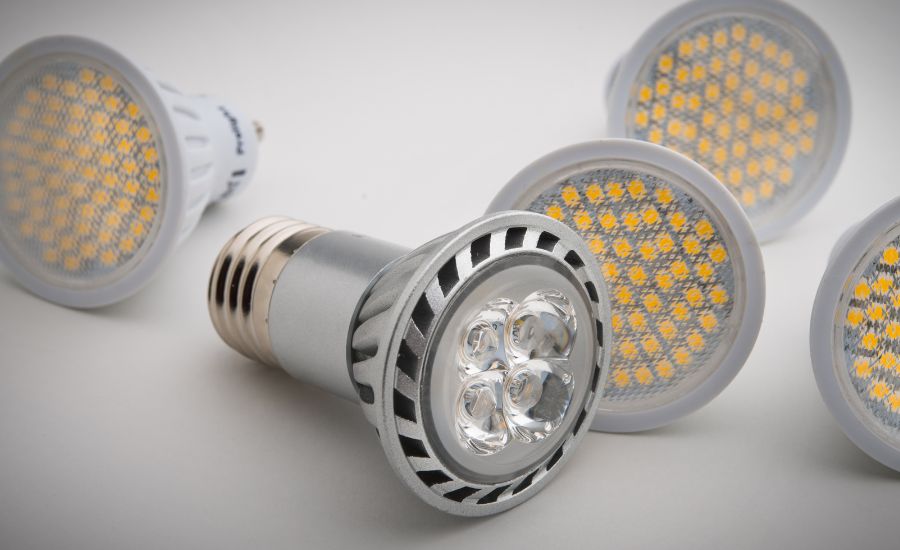How to reduce heat from led lights? LED lights are very popular in the modern world, and no wonder – compared to the other types of lighting (fluorescent, halogen, or incandescent lights), it has a lot of advantages: they are more versatile, efficient, and long-lasting.
However, there is one common misconception about LED light that many people still believe in – that LED bulbs don’t produce any heat.

Do LED lights produce heat?
Yes, contrary to popular belief, LED lights generate heat.
And even though the heat amount is lower compared to how much heat other light sources may produce, it is still important to know how you can reduce heat from LED lights.
Some companies producing LED lighting participate in spreading this misinformation by claiming that their lamps do not generate heat at all.
Why do LED lights produce heat?
Heat is generated by using electricity, and it’s no exception for any electrical device. The reason why an LED light system produces less heat is that it requires less electricity yet emits light of the same capacity.
Before we move on to the tips on how to reduce heat from led lights, let’s find out why exactly this happens in the first place.

The factors affecting how much heat is generated by LED lights
LED lighting system manufacturers keep making their products more efficient, and current LED bulbs have less heat produced compared to their predecessors. The amount of heat generated by modern LED lights is extremely low.
Another factor is the type of LED bulb you’re using. For instance, LED flood light is usually pretty bright big LED lights so they consume more energy.
Plus, LED bulbs in such lamps are tightly compacted, which results in more heat generating and accumulating in a smaller area.
On the other hand, LED light strips or tapes are usually used in areas that don’t require that much light, and, due to their shape, the heat distributes evenly throughout the surface of the lamp, making it less significant.
Reasons for and negative effects of overheating
Now let’s talk about why sometimes LED lights may overheat and what consequences this may bring.
Reasons for LED lights overheating
Here are the most common reasons why your LED lights may get hotter than they should.
Warm environment
LED lights are typically designed to operate under certain temperatures, and if the surroundings are too warm, this will consequently lead to the LEDs overheating.
Poor quality
When purchasing low-quality products, you always risk getting a malfunctioning product. Poor quality materials, poor design, and low manufacturing standards may result in your lights overheating and malfunctioning.

Negative effects of overheating
Even though there’s a very low chance your LED lights may overheat to the point of causing any damage, it’s still worth checking your lighting to avoid possible negative effects.
Reduced lights lifespan
This is one of the most common effects of overheating. Excessive heat may easily damage the lamp’s inner components to the point that it shortens the LED lamp’s lifespan.
Lower brightness
If you’ve noticed that over time the light in your room got dimmer, even if the lamp originally produced enough light, this may also be an effect of overheating.
Fire hazard
LED lights themselves are not capable of starting a fire due to their design, however, improper installation and poor wiring, when met with overheated bulbs, can very well cause a fire in the surrounding area.

Tips on how to reduce heat from LED lights
Now we know why it is so important to prevent overheating in LED lights, and we can move on to the information on how to reduce heat from LED lights and avoid any damage.
Even heat distribution
Even distribution is a great solution to reduce heat from LED lights. One of the ways to do so is by using a quality heat sink.
The heat sink is an element of an LED lamp responsible for regulating the internal temperature by absorbing heat from the LED and releasing it into the environment. LED Heatsinks include spread fins made up of extruded aluminum to minimize thermal resistance from the base of the fins.
Quality heat sinks can be made up of various materials with high thermal conductivity, such as aluminum, gold, or copper.
The size of LED heat sinks is also important. You may need a thicker heat sink to transfer heat more efficiently.
High-quality LED lamps already include effective heat sinks, but you can always replace them or add more, if necessary.
Another way to even heat dissipation is installing your LED lights on a heat-dissipating material/surface. For instance, it can be an aluminum plate placed on the back of the lamp.
You may also mount your lighting right onto the ceiling or another surface, instead of hanging it down from the ceiling. This way, there is no space between the source of heat and the surface it can be evenly distributed to. Make sure there are no gaps in between to dissipate heat more efficiently.

Ambient temperature
Going back to the topic of operating in a warm environment – make sure to always read the manufacturer’s recommendations for the maximum operating temperature of the lighting system you’re choosing.
If your ambient temperature is higher than recommended, you may need to consider other lighting options or take extra active steps to reduce heat output. This especially concerns rooms where extra sources of heat are frequently used, such as kitchens.
Good ventilation
This is another great and easy way to dissipate heat and prevent overheating. Make sure the area where your LED lights are installed has proper and regular ventilation. This brings us back to the previous point – the higher the ambient temperature is, the more ventilation and airflow are required.
This also means that LED lights shouldn’t be installed in constantly enclosed spaces without proper ventilation. If this cannot be avoided, think of other ways to reduce heat generated by LEDs. One of them is active cooling.

Active cooling
Today, there are many special LED cooler types or ventilation systems on the market to choose from.
Some lights already come equipped with LED coolers.
Other LED cooler options are special liquid cooling or cooling gels.
Choosing optimal wattage
Often people tend to buy lighting that’s too powerful for their spaces, fearing that it won’t be enough. This results in too much heat generated by the LED lamps. To avoid that, always make sure you select the optimal wattage for your space.
Using dimmers
You can always reduce heat from LED lights by using special dimmers. They help control the amount of power consumed and heat produced. It’s also a great way of setting up comfortable lighting for any situation.

FAQ
How do I stop my LED lights from getting hot?
Most importantly, make sure you’re choosing optimal and good-quality lighting for your area and follow the instructions for proper installation.
Why are my LED lights so hot?
The surrounding environment may be too hot, which doesn’t let the heat the LED lights produce get released as quickly. Other factors can include low-quality lighting and improper installation.
How do you cool down LED lights?
The most important tips on how to reduce heat from led lights include ensuring proper ventilation and avoiding enclosed spaces where heat can easily build up. If needed, use additional active cooling methods for your lighting systems.
Is it OK for LED lights to get hot?
Having your LED lights overheated may cause damage to the lights themselves, reduce the overall lamp life, or even lower the light output.
In conclusion
Without a doubt, LED light bulbs are the best option for safe and more efficient lighting than, say, halogen bulbs or incandescent light bulbs, and by following the easy tips on how to reduce heat from led lights provided in this article, you will be enjoying your cool led lights for a long time without any concerns.


